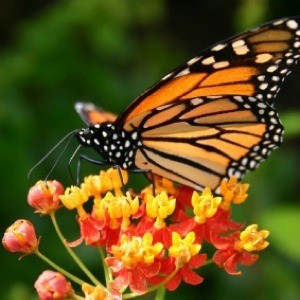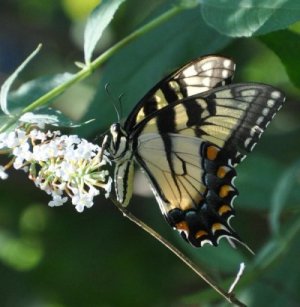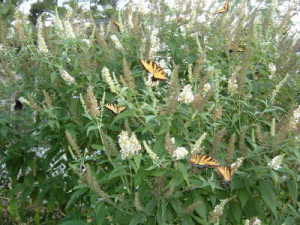
Monarch butterfly populations are in trouble. Each fall, hundreds of millions of them migrate from the United Stated and Canada to the mountains in Mexico where they wait out the winter. Each spring, they make the long trip back in order to breed. This colossal migration is truly considered one of the world's greatest natural wonders.
In the past few years, a loss of breeding habitat has caused a decline in the Monarch's overall populations. Unfortunately this year, as much as 60 percent of the remaining breeding colonies in Mexico were killed by winter storms. As a result, Monarch populations are as low as they've been in more than three decades. Here's what you can do to help.
To reproduce successive generations of offspring, Monarch butterflies need two things: host plants for their larvae (milkweed), and energy sources (nectar plants) for the adults. Adult monarchs feed on nectar from a variety of different plants, but they are choosy about where they lay their eggs. Female monarchs will only lay their eggs on a handful of species of milkweed.
Currently, an increasing number of milkweed plants (and monarch habitats) are being lost due to development, as well as the widespread use of agricultural herbicides. Because ninety percent of Monarch habitat occurs in agricultural settings, and remaining native habitats are fragmented, creating and maintaining a Monarch butterfly habitat in your garden will help to conserve their populations.
Seed Collection and Storage: To attract the greatest number of monarchs, it's a good idea to plant a variety of milkweed species. The first step is to find out what types of milkweed are common to your area. Obtain seeds or bedding plants from a native plant nursery in your area or order them online. You can also wait until fall and collect seeds by hand. Look for milkweed plants in areas where the soil has been disturbed: roadsides, pastures, bike paths, along railroad tracks, highway medians, fields, or parks. When the milkweed pods look like they are ready to burst, remove the seeds from the pods (don't worry about the silks), and store them in an airtight container until you're ready to plant them in the spring. To prevent seeds from rotting due to moisture, add a packet of silica gel to the container.
Site Selection: Milkweed grows best in a location that receives at least 6 hours of sun per day. Most species prefer light soils with ample drainage (slopes and raised beds work well for this), except for Swamp milkweed, which does well in wet conditions.
Starting Seeds Indoors: Milkweed seedlings can be started indoors and transplanted outdoors after the average date of last frost. To plant seeds, fill plastic flats with a pre-moistened seed-starting mix. Scatter the seeds on top of the soil 1/4-1/2 inch apart and cover them with 1/4 inch of soil. Gently mist the soil's surface to "fix" the seeds in place. Place the flats under fluorescent lights (or in a sunny window sill) and keep the seeds moist (not wet). At 75 degrees F, expect the seeds to germinate in 7-10 days.
As seedlings grow, thin them as necessary to provide adequate air circulation and encourage plants with strong, sturdy stems. When the plants reach 4-6 inches tall, harden them off and transplant them outdoors. Seedling should be spaced 1-2 feet apart. Add a protective layer of mulch to help them retain moisture. Note: Wrapping the seeds in paper towels and soaking them in warm water for 24 hours prior to planting is said to increase germination rates.
Cold Treatment of Seeds: To mimic the conditions found in nature, the seeds of milkweed species grown in northern climates should be cold treated to increase germination rates (tropical species don't require this). Place the seeds in a plastic bag filled with moist peat or potting soil and store them in a cold (41 degrees F), dark place. The refrigerator is fine. As an alternative, you can also place the seeds between moist paper towels in a plastic bag. After a period of at least 3-6 weeks, the seeds can be planted in warm (70 degrees F), moist soil.
To make the long migratory journey each fall, adult monarchs need the energy of nectar producing flowers. Lots of annual and perennial flowers, as well as flowering shrubs are good sources of nectar. Here's a partial list: www.monarchwatch.org/garden/nectar.htm
For more information on Monarch butterflies and how you can create a "Monarch Waystation" for migrating butterflies, visit: www.monarchwatch.org

About The Author: Ellen Brown is an environmental writer and photographer and the owner of Sustainable Media, an environmental media company that specializes in helping businesses and organizations promote eco-friendly products and services. Contact her on the web at http://www.sustainable-media.com
Add your voice! Click below to comment. ThriftyFun is powered by your wisdom!
We have two Butterfly bushes and it's amazing how many butterflies it attracts. This beautiful picture was taken by our son.

Our two butterfly bushes are located just outside the kitchen window. Every day the number of butterflies that come to the bush increases. They come early in the morning and stay around the bush all day, until almost dark. It's awesome!!
Today, I counted 12 large Eastern Tiger Swallowtails and there are many small butterflies on the bush as well. I don't know what they are.

Wow. I had no idea this was happening. I've been planting more plants that help attract butterflies, just because I like them, but that obviously is not enough. Here's a good overview on which plants to pick.
www.oldhouseweb.com/
Hatelitter, that is a beautiful photo. I really love it. Your son did a great job!
Marz
Another important way to help monarchs is to recognize their caterpillars and be careful not to harm them. They are striped black, white and yellow and in the garden feed on parsley and dill plants. I made the mistake of killing one before I knew what it was. I now plant extra parsley and dill to make sure there is plenty for us AND the monarchs.
VERY Important to KNOW what the caterpillar's look like, Many years ago I did not know, the day before computers. I saw some of these on my plant and thought they were eating and killing my plant, I picked them and put into some water..:'( OMG then when I found out they were going to grow up to be Monarch butterflies I cried and cried how could I have not known and killed them. I now grow so many things for the monarch's many different Milkweeds and butterfly weeds, and dill and other nectar plants. I will never forgive myself for doing this , NOW I sell seeds on Etsy and everything is for the Monarch butterfly, I give free milkweed seeds away just to save the butterflies..... I had learned the hard way.
When I lived in southern, C.A I saw (what I assume was migration) there were hundreds of Monarchs flying along, when the traffic light changed I drove ever so slowly (wanted to just sit there until they got by) I now live in Omaha, N.E and have several nectar flowers in my yard (They love the Asclepias plants and Butterfly bush are their favorites. Not sure if they visit the Pentas, but the bees sure do, and the hummingbirds. Linda H.
Add your voice! Click below to comment. ThriftyFun is powered by your wisdom!